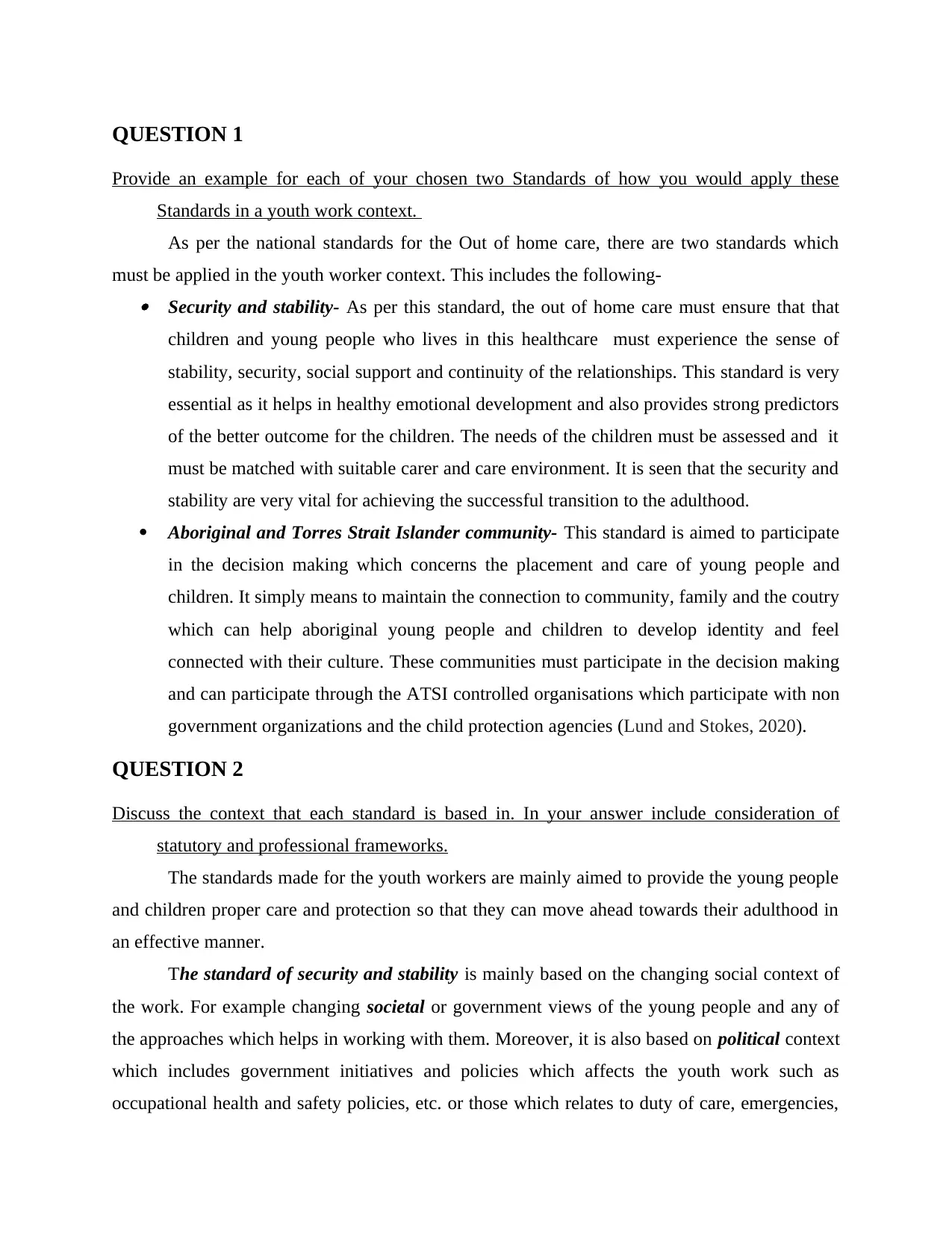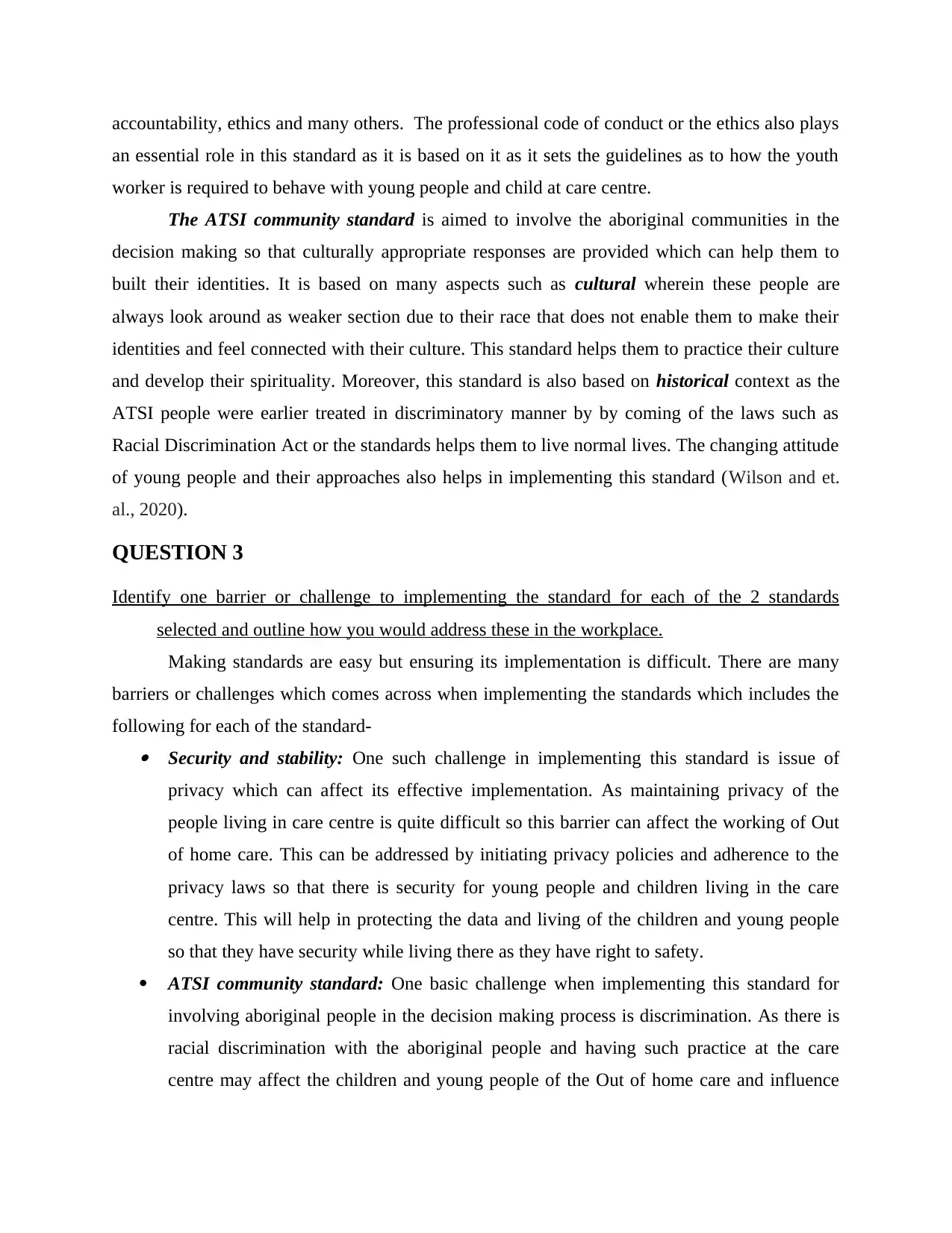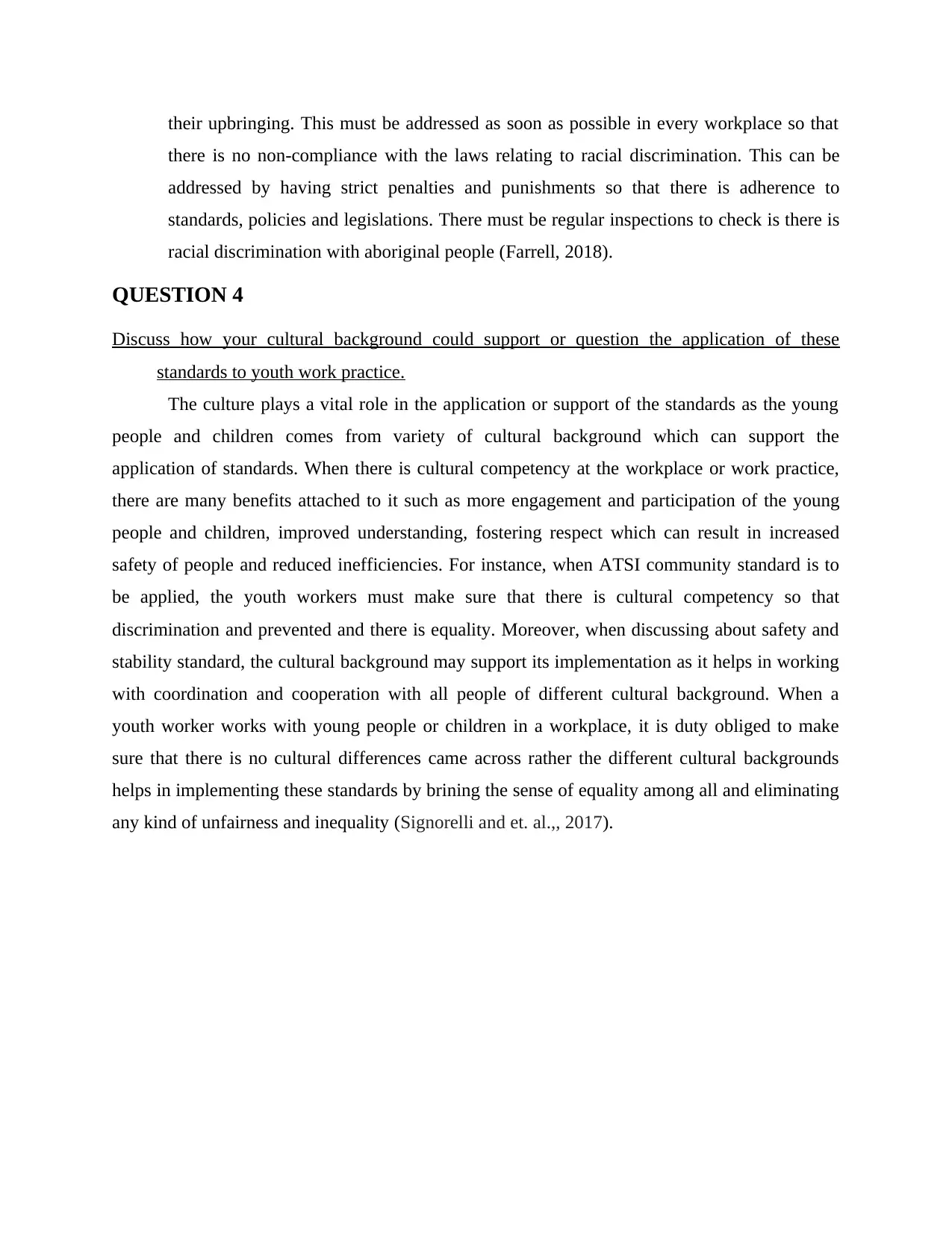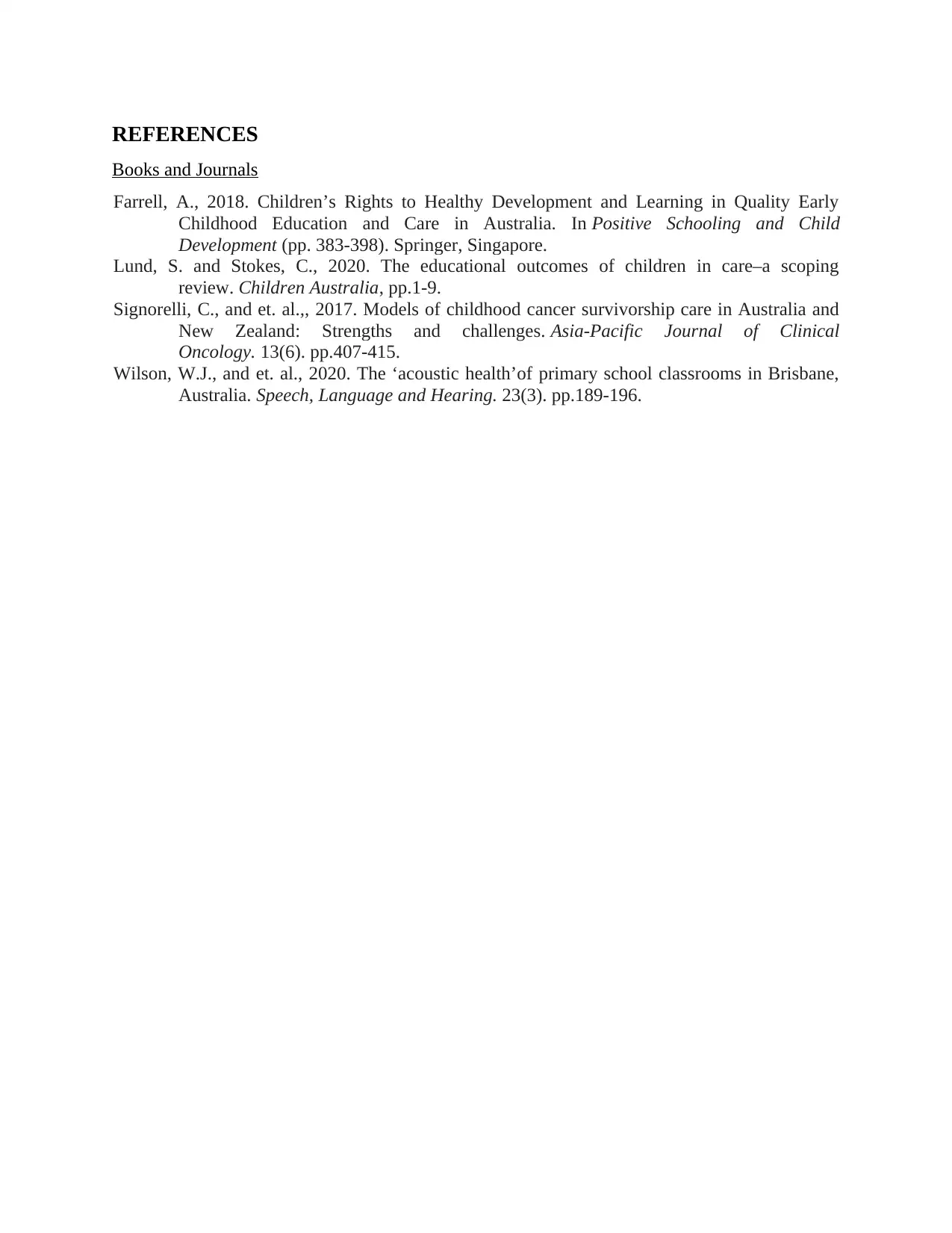Security, Stability, and ATSI Community Standards in Youth Work
VerifiedAdded on 2023/06/18
|6
|1405
|493
Report
AI Summary
This report examines the application of two key standards in youth work: security and stability for young people in out-of-home care, and the involvement of Aboriginal and Torres Strait Islander (ATSI) communities in decisions affecting young people. It discusses the importance of security and stability for emotional development and successful transition to adulthood, and the need for ATSI community involvement to maintain cultural connections and identity. The report also explores the contexts in which these standards are based, including statutory and professional frameworks, and identifies challenges to implementation such as privacy concerns and racial discrimination. It suggests addressing these challenges through privacy policies, adherence to anti-discrimination laws, and promoting cultural competency in the workplace, highlighting how diverse cultural backgrounds can support the effective implementation of these standards by fostering equality and respect.

Short Answer
Paraphrase This Document
Need a fresh take? Get an instant paraphrase of this document with our AI Paraphraser

Table of Contents
QUESTION 1...................................................................................................................................3
Provide an example for each of your chosen two Standards of how you would apply these
Standards in a youth work context. .......................................................................................3
QUESTION 2...................................................................................................................................3
Discuss the context that each standard is based in. In your answer include consideration of
statutory and professional frameworks...................................................................................3
QUESTION 3...................................................................................................................................4
Identify one barrier or challenge to implementing the standard for each of the 2 standards
selected and outline how you would address these in the workplace.....................................4
QUESTION 4...................................................................................................................................5
Discuss how your cultural background could support or question the application of these
standards to youth work practice............................................................................................5
REFERENCES................................................................................................................................6
QUESTION 1...................................................................................................................................3
Provide an example for each of your chosen two Standards of how you would apply these
Standards in a youth work context. .......................................................................................3
QUESTION 2...................................................................................................................................3
Discuss the context that each standard is based in. In your answer include consideration of
statutory and professional frameworks...................................................................................3
QUESTION 3...................................................................................................................................4
Identify one barrier or challenge to implementing the standard for each of the 2 standards
selected and outline how you would address these in the workplace.....................................4
QUESTION 4...................................................................................................................................5
Discuss how your cultural background could support or question the application of these
standards to youth work practice............................................................................................5
REFERENCES................................................................................................................................6

QUESTION 1
Provide an example for each of your chosen two Standards of how you would apply these
Standards in a youth work context.
As per the national standards for the Out of home care, there are two standards which
must be applied in the youth worker context. This includes the following- Security and stability- As per this standard, the out of home care must ensure that that
children and young people who lives in this healthcare must experience the sense of
stability, security, social support and continuity of the relationships. This standard is very
essential as it helps in healthy emotional development and also provides strong predictors
of the better outcome for the children. The needs of the children must be assessed and it
must be matched with suitable carer and care environment. It is seen that the security and
stability are very vital for achieving the successful transition to the adulthood.
Aboriginal and Torres Strait Islander community- This standard is aimed to participate
in the decision making which concerns the placement and care of young people and
children. It simply means to maintain the connection to community, family and the coutry
which can help aboriginal young people and children to develop identity and feel
connected with their culture. These communities must participate in the decision making
and can participate through the ATSI controlled organisations which participate with non
government organizations and the child protection agencies (Lund and Stokes, 2020).
QUESTION 2
Discuss the context that each standard is based in. In your answer include consideration of
statutory and professional frameworks.
The standards made for the youth workers are mainly aimed to provide the young people
and children proper care and protection so that they can move ahead towards their adulthood in
an effective manner.
The standard of security and stability is mainly based on the changing social context of
the work. For example changing societal or government views of the young people and any of
the approaches which helps in working with them. Moreover, it is also based on political context
which includes government initiatives and policies which affects the youth work such as
occupational health and safety policies, etc. or those which relates to duty of care, emergencies,
Provide an example for each of your chosen two Standards of how you would apply these
Standards in a youth work context.
As per the national standards for the Out of home care, there are two standards which
must be applied in the youth worker context. This includes the following- Security and stability- As per this standard, the out of home care must ensure that that
children and young people who lives in this healthcare must experience the sense of
stability, security, social support and continuity of the relationships. This standard is very
essential as it helps in healthy emotional development and also provides strong predictors
of the better outcome for the children. The needs of the children must be assessed and it
must be matched with suitable carer and care environment. It is seen that the security and
stability are very vital for achieving the successful transition to the adulthood.
Aboriginal and Torres Strait Islander community- This standard is aimed to participate
in the decision making which concerns the placement and care of young people and
children. It simply means to maintain the connection to community, family and the coutry
which can help aboriginal young people and children to develop identity and feel
connected with their culture. These communities must participate in the decision making
and can participate through the ATSI controlled organisations which participate with non
government organizations and the child protection agencies (Lund and Stokes, 2020).
QUESTION 2
Discuss the context that each standard is based in. In your answer include consideration of
statutory and professional frameworks.
The standards made for the youth workers are mainly aimed to provide the young people
and children proper care and protection so that they can move ahead towards their adulthood in
an effective manner.
The standard of security and stability is mainly based on the changing social context of
the work. For example changing societal or government views of the young people and any of
the approaches which helps in working with them. Moreover, it is also based on political context
which includes government initiatives and policies which affects the youth work such as
occupational health and safety policies, etc. or those which relates to duty of care, emergencies,
⊘ This is a preview!⊘
Do you want full access?
Subscribe today to unlock all pages.

Trusted by 1+ million students worldwide

accountability, ethics and many others. The professional code of conduct or the ethics also plays
an essential role in this standard as it is based on it as it sets the guidelines as to how the youth
worker is required to behave with young people and child at care centre.
The ATSI community standard is aimed to involve the aboriginal communities in the
decision making so that culturally appropriate responses are provided which can help them to
built their identities. It is based on many aspects such as cultural wherein these people are
always look around as weaker section due to their race that does not enable them to make their
identities and feel connected with their culture. This standard helps them to practice their culture
and develop their spirituality. Moreover, this standard is also based on historical context as the
ATSI people were earlier treated in discriminatory manner by by coming of the laws such as
Racial Discrimination Act or the standards helps them to live normal lives. The changing attitude
of young people and their approaches also helps in implementing this standard (Wilson and et.
al., 2020).
QUESTION 3
Identify one barrier or challenge to implementing the standard for each of the 2 standards
selected and outline how you would address these in the workplace.
Making standards are easy but ensuring its implementation is difficult. There are many
barriers or challenges which comes across when implementing the standards which includes the
following for each of the standard- Security and stability: One such challenge in implementing this standard is issue of
privacy which can affect its effective implementation. As maintaining privacy of the
people living in care centre is quite difficult so this barrier can affect the working of Out
of home care. This can be addressed by initiating privacy policies and adherence to the
privacy laws so that there is security for young people and children living in the care
centre. This will help in protecting the data and living of the children and young people
so that they have security while living there as they have right to safety.
ATSI community standard: One basic challenge when implementing this standard for
involving aboriginal people in the decision making process is discrimination. As there is
racial discrimination with the aboriginal people and having such practice at the care
centre may affect the children and young people of the Out of home care and influence
an essential role in this standard as it is based on it as it sets the guidelines as to how the youth
worker is required to behave with young people and child at care centre.
The ATSI community standard is aimed to involve the aboriginal communities in the
decision making so that culturally appropriate responses are provided which can help them to
built their identities. It is based on many aspects such as cultural wherein these people are
always look around as weaker section due to their race that does not enable them to make their
identities and feel connected with their culture. This standard helps them to practice their culture
and develop their spirituality. Moreover, this standard is also based on historical context as the
ATSI people were earlier treated in discriminatory manner by by coming of the laws such as
Racial Discrimination Act or the standards helps them to live normal lives. The changing attitude
of young people and their approaches also helps in implementing this standard (Wilson and et.
al., 2020).
QUESTION 3
Identify one barrier or challenge to implementing the standard for each of the 2 standards
selected and outline how you would address these in the workplace.
Making standards are easy but ensuring its implementation is difficult. There are many
barriers or challenges which comes across when implementing the standards which includes the
following for each of the standard- Security and stability: One such challenge in implementing this standard is issue of
privacy which can affect its effective implementation. As maintaining privacy of the
people living in care centre is quite difficult so this barrier can affect the working of Out
of home care. This can be addressed by initiating privacy policies and adherence to the
privacy laws so that there is security for young people and children living in the care
centre. This will help in protecting the data and living of the children and young people
so that they have security while living there as they have right to safety.
ATSI community standard: One basic challenge when implementing this standard for
involving aboriginal people in the decision making process is discrimination. As there is
racial discrimination with the aboriginal people and having such practice at the care
centre may affect the children and young people of the Out of home care and influence
Paraphrase This Document
Need a fresh take? Get an instant paraphrase of this document with our AI Paraphraser

their upbringing. This must be addressed as soon as possible in every workplace so that
there is no non-compliance with the laws relating to racial discrimination. This can be
addressed by having strict penalties and punishments so that there is adherence to
standards, policies and legislations. There must be regular inspections to check is there is
racial discrimination with aboriginal people (Farrell, 2018).
QUESTION 4
Discuss how your cultural background could support or question the application of these
standards to youth work practice.
The culture plays a vital role in the application or support of the standards as the young
people and children comes from variety of cultural background which can support the
application of standards. When there is cultural competency at the workplace or work practice,
there are many benefits attached to it such as more engagement and participation of the young
people and children, improved understanding, fostering respect which can result in increased
safety of people and reduced inefficiencies. For instance, when ATSI community standard is to
be applied, the youth workers must make sure that there is cultural competency so that
discrimination and prevented and there is equality. Moreover, when discussing about safety and
stability standard, the cultural background may support its implementation as it helps in working
with coordination and cooperation with all people of different cultural background. When a
youth worker works with young people or children in a workplace, it is duty obliged to make
sure that there is no cultural differences came across rather the different cultural backgrounds
helps in implementing these standards by brining the sense of equality among all and eliminating
any kind of unfairness and inequality (Signorelli and et. al.,, 2017).
there is no non-compliance with the laws relating to racial discrimination. This can be
addressed by having strict penalties and punishments so that there is adherence to
standards, policies and legislations. There must be regular inspections to check is there is
racial discrimination with aboriginal people (Farrell, 2018).
QUESTION 4
Discuss how your cultural background could support or question the application of these
standards to youth work practice.
The culture plays a vital role in the application or support of the standards as the young
people and children comes from variety of cultural background which can support the
application of standards. When there is cultural competency at the workplace or work practice,
there are many benefits attached to it such as more engagement and participation of the young
people and children, improved understanding, fostering respect which can result in increased
safety of people and reduced inefficiencies. For instance, when ATSI community standard is to
be applied, the youth workers must make sure that there is cultural competency so that
discrimination and prevented and there is equality. Moreover, when discussing about safety and
stability standard, the cultural background may support its implementation as it helps in working
with coordination and cooperation with all people of different cultural background. When a
youth worker works with young people or children in a workplace, it is duty obliged to make
sure that there is no cultural differences came across rather the different cultural backgrounds
helps in implementing these standards by brining the sense of equality among all and eliminating
any kind of unfairness and inequality (Signorelli and et. al.,, 2017).

REFERENCES
Books and Journals
Farrell, A., 2018. Children’s Rights to Healthy Development and Learning in Quality Early
Childhood Education and Care in Australia. In Positive Schooling and Child
Development (pp. 383-398). Springer, Singapore.
Lund, S. and Stokes, C., 2020. The educational outcomes of children in care–a scoping
review. Children Australia, pp.1-9.
Signorelli, C., and et. al.,, 2017. Models of childhood cancer survivorship care in Australia and
New Zealand: Strengths and challenges. Asia‐Pacific Journal of Clinical
Oncology. 13(6). pp.407-415.
Wilson, W.J., and et. al., 2020. The ‘acoustic health’of primary school classrooms in Brisbane,
Australia. Speech, Language and Hearing. 23(3). pp.189-196.
Books and Journals
Farrell, A., 2018. Children’s Rights to Healthy Development and Learning in Quality Early
Childhood Education and Care in Australia. In Positive Schooling and Child
Development (pp. 383-398). Springer, Singapore.
Lund, S. and Stokes, C., 2020. The educational outcomes of children in care–a scoping
review. Children Australia, pp.1-9.
Signorelli, C., and et. al.,, 2017. Models of childhood cancer survivorship care in Australia and
New Zealand: Strengths and challenges. Asia‐Pacific Journal of Clinical
Oncology. 13(6). pp.407-415.
Wilson, W.J., and et. al., 2020. The ‘acoustic health’of primary school classrooms in Brisbane,
Australia. Speech, Language and Hearing. 23(3). pp.189-196.
⊘ This is a preview!⊘
Do you want full access?
Subscribe today to unlock all pages.

Trusted by 1+ million students worldwide
1 out of 6
Related Documents
Your All-in-One AI-Powered Toolkit for Academic Success.
+13062052269
info@desklib.com
Available 24*7 on WhatsApp / Email
![[object Object]](/_next/static/media/star-bottom.7253800d.svg)
Unlock your academic potential
Copyright © 2020–2025 A2Z Services. All Rights Reserved. Developed and managed by ZUCOL.





